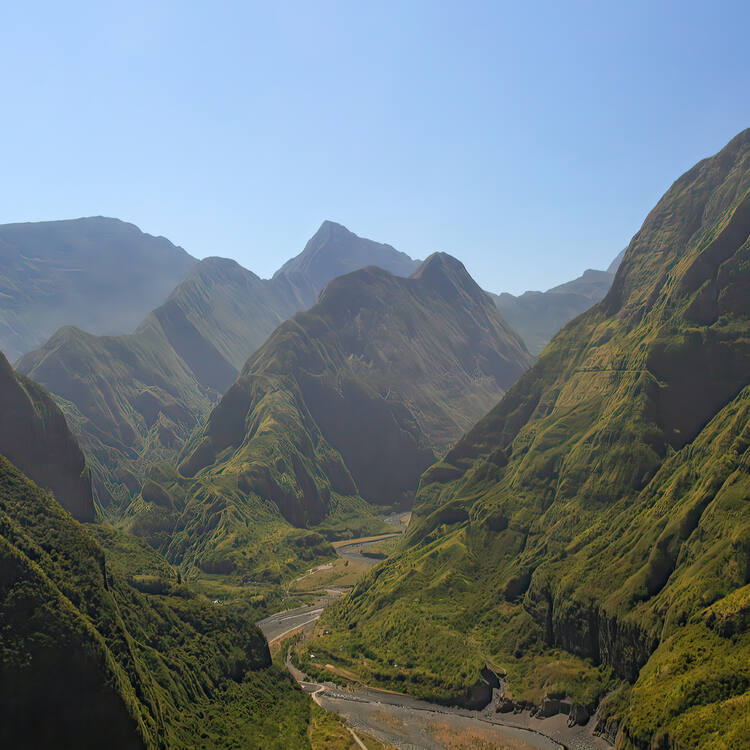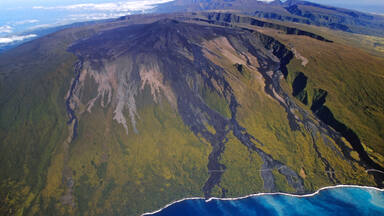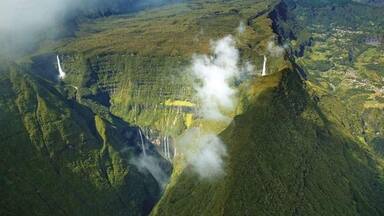Pitons, cirques and remparts of Reunion Island
Pitons, cirques and remparts of Reunion Island
The Pitons, cirques and remparts of Reunion Island site coincides with the core zone of La Réunion National Park. The property covers more than 100,000 ha or 40 % of La Réunion, an island comprising two adjoining volcanic massifs located in the south-west of the Indian Ocean. Dominated by two towering volcanic peaks, massive walls and three cliff-rimmed cirques, the property includes a great variety of rugged terrain and impressive escarpments, forested gorges and basins creating a visually striking landscape. It is the natural habitat for a wide diversity of plants, presenting a high level of endemism. There are subtropical rainforests, cloud forests and heaths creating a remarkable and visually appealing mosaic of ecosystems and landscape features.
Description is available under license CC-BY-SA IGO 3.0
Pitons, cirques et remparts de l’île de la Réunion
Ce bien coïncide avec la zone centrale du Parc national de la Réunion. Il couvre une superficie de plus de 100 000 ha, soit 40% de la Réunion, une île composée de deux massifs volcaniques située dans le sud ouest de l'océan Indien. Dominé par deux pics volcaniques, le site présente une grande diversité d'escarpements, de gorges et de bassins boisés qui, ensemble, créent un paysage spectaculaire. Il sert d'habitat naturel à une grande diversité de plantes présentant un degré d'endémisme élevé. On y trouve des forêts ombrophiles subtropicales, des forêts de brouillard et des landes, le tout formant une mosaïque d'écosystèmes et de caractéristiques paysagères remarquables.
Description is available under license CC-BY-SA IGO 3.0
شِعاف جزيرة ريونيون وجروفها وحلباتها الجليدية
يوجد هذا الموقع في المنطقة المركزية من المرتع الوطني لجزيرة ريونيون (المحيط الهندي). وهو يغطي مساحة تبلغ أكثر من 100000 هكتار، أي ما يعادل 40℅ من الريونيون ـ الجزيرة المؤلفة من كتلتين جبليتين بركانيتين والتي تقع في جنوب غرب المحيط الهندي. ويضم الموقع، الذي تطل عليه قمتان بركانيتان، أنواعاً كثيرة من المنحدرات الشديدة، والأخاديد والأحواض المُشجّرة التي تمثل، في مجموعها، منظراً خلاباً. كما أنه يُعتبر منبتاً طبيعياً لزراعات كثيرة التنوع استوطنت هناك منذ عهد بعيد. وتوجد في هذا المنبت غابات مطيرة شبه استوائية، وغابات تغطيها الغيوم وأراضٍ بائرة، بحيث يؤلف مجموع هذه العناصر أشكالاً مختلفة من نُظم إيكولوجية ومناظر ذات خصائص متميزة.
source: UNESCO/CPE
Description is available under license CC-BY-SA IGO 3.0
留尼汪岛的山峰,冰斗和峭壁
这一自然遗址与留尼汪国家公园的中心区相邻,占地10多万公顷,即相当于留尼汪岛面积的40%。留尼汪岛由两座位于印度洋西南部的火山山脉组成。在此遗址内,两座高耸的火山峰、巨大的峭壁与三座悬崖边的冰斗俯瞰着岛屿,其下峭壁与森林覆盖着的峡谷与盆地交相呼应,共同形成一幅壮阔的图画。这里是植物的天然栖息地,不仅植物种类繁多,而且多为本地独特的品种。亚热带雨林、云雾林和沼泽地交织在一起,宛如一个由生态系统和各种景物组成的马赛克。
source: UNESCO/CPE
Description is available under license CC-BY-SA IGO 3.0
Пики, кратеры и валы на острове Реюньон
Этот объект включает центральную зону национального парка острова Реюньон. Его площадь превышает 100 тысяч га, составляя 40% общей площади этого острова в юго-западной части Индийского океана. Его наивысшими точками являются две горы вулканической природы. Здесь разбросаны множество скал, ущелий и лесных бассейнов, которые в совокупности создают пейзаж удивительной красоты. Объект является естественной средой обитания для самых разнообразных растений с высокой степенью эндемизма. Произрастающие здесь тенистые субтропические леса, влажные леса и болота образуют замечательную и приятную для глаза мозаику из экосистем и ландшафтов.
source: UNESCO/CPE
Description is available under license CC-BY-SA IGO 3.0
Pitones, circos y escarpaduras de la Isla de la Reunión
Este sitio abarca la zona central del Parque Nacional de la Isla de la Reunión, esto es, una extensión de 100.000 hectáreas equivalente al 40% de la superficie de esta isla, que está ubicada al sudoeste del Océano Índico y cuenta con dos macizos volcánicos. Dominado por dos picos volcánicos, el sitio posee un conjunto de escarpaduras, desfiladeros y lagunas con bosques, que forman un paisaje espectacular. Es el hábitat natural de una gran variedad de plantas con un alto grado de endemismo. Los bosques umbrófilos subtropicales, los bosques de niebla y las landas que pueblan el sitio forman todo un mosaico de ecosistemas y un paisaje de características excepcionales.
source: UNESCO/CPE
Description is available under license CC-BY-SA IGO 3.0
レユニオン島の火山峰、圏谷と岩壁群
この遺産は、インド洋の南西に位置するレユニオン島にあるレユニオン国立公園の核心地域にあたる。2つの隣り合った火山を有するレユニオン島の40%を占め、10万ha以上ある。火山峰、岩壁、断崖に囲まれた圏谷などがあり、変化に富んだ起伏のある地形や見事な急崖、樹木に覆われた深い峡谷が、美しい景観を生みだしている。亜熱帯の雨林や雲霧林、低木林などが、複雑な生態系を形成しており、固有種に富んだ、多様な植物の生育地となっている。ここは、マスカリン諸島の陸域の生物多様性の保全のために最も重要な地域である。source: NFUAJ
Pitons, keteldalen en wallen van het eiland Réunion
De Pitons, keteldalen en wallen van het eiland Réunion vallen samen met de kernzone van het nationaal park La Réunion. Het gebied omvat meer dan 100.000 hectare, 40% van La Réunion, een eiland met twee aangrenzende vulkanische massieven in het zuidwesten van de Indische Oceaan. Het gebied wordt gedomineerd door twee torenhoge vulkanische toppen, massieve bergwanden en drie klifomrande keteldalen. Het herbergt een grote verscheidenheid aan ruig terrein, beboste kloven en bekkens. Het eiland kent verder subtropische regenwouden, nevelwouden en open velden, die samen een mooi mozaïek vormen van ecosystemen en landschapselementen.
Source: unesco.nl
Outstanding Universal Value
Brief synthesis
The area of Pitons, cirques and remparts of Reunion Island coincides with the core zone of La Réunion National Park. The property covers more than 100,000 ha or 40 % of La Réunion, an island comprised of two adjoining volcanic massifs located in the south-west of the Indian Ocean. Dominated by two towering volcanic peaks, massive walls and three cliff-rimmed cirques, the property includes a great variety of rugged terrain and impressive escarpments, forested gorges and basins creating a visually striking landscape. The property harbours the most valuable natural habitats and the species assemblages they support remaining on the Mascarene Island group. It protects key parts of a recognized global centre of plant diversity and features a remarkably high level of endemism across many taxa. Thereby, Pitons, cirques and remparts of Reunion Island is the most significant and important contribution to the conservation of the terrestrial biodiversity of the Mascarene Islands.
Criterion (vii): The combination of volcanism, tectonic landslide events, heavy rainfall and stream erosion have formed a rugged and dramatic landscape of striking beauty, dominated by two towering volcanoes, the dormant Piton de Neiges and the highly active Piton de la Fournaise. Other major landscape features include "Remparts" - steep rock walls of varying geological age and character, and so-called "cirques", which can be described as massive natural amphitheatres with an imposing height and verticality. There are deep, partly forested gorges and escarpments, with subtropical rainforests, cloud forests and heaths creating a remarkable and visually appealing mosaic of ecosystems and landscape features.
Criterion (x): The property is a global centre of plant diversity with a high degree of endemism. It contains the most significant remaining natural habitats for the conservation of the terrestrial biodiversity of the Mascarene Islands, including a range of rare forest types. Given the major and partly irreversible human impacts on the environment in the Mascarene archipelago, the property serves as the last refuge for the survival of a large number of endemic, threatened and endangered species.
Integrity
Building upon earlier forest and nature conservation efforts, La Réunion National Park was established in 2007. This status provides an adequate legal framework to ensure the protection of the property, whose boundaries coincide with that of the national park. The boundaries of the property encompass the exceptional features of the natural landscape, as well as almost the entire remaining natural or close-to natural ecosystems remaining on La Réunion and thus the key biodiversity values.
The integrity of the property is subject to a range of threats. Despite ongoing management efforts, invasive alien species are a permanent management challenge posing a very real threat to the biodiversity values of the property. Evidence of past losses of many native species on La Réunion and on other islands of the Mascarene archipelago underlines the severity of this threat.
Protection and management requirements
The property benefits from effective legal protection through its designation as a National Park. Ensuring the Outstanding Universal Value of the property requires an effective and adaptive implementation of the evolving management plan for La Réunion National Park, and adequate long-term staffing and financial resources. The management of the national park draws on comprehensive consultation with governmental and civil society stakeholders and benefits from structured on science, research, socio-economics and cultural issues. Meaningful and effective consultation with all of the concerned stakeholders, including communities who live within its buffer zones and surrounding areas, is indispensable.
Actions are required in response to a number of specific threats, to ensure the maintenance and enhancement of the Outstanding Universal Value. Efforts to reduce invasions, permanent monitoring, and the implementation of a comprehensive strategy to control and eradicate invasive alien species are indispensible and will require long-term and continuing efforts and significant ongoing funding. While the rugged terrain provides a degree of natural protection against encroachment and human economic activities, such as agriculture, forestry, energy production and tourism; must be managed both in the property and its buffer zone in a way that is not in conflict with the integrity of the property.
The development and effective implementation of a comprehensive tourism development strategy addressing the strong demand is also necessary. There is fine balance between positive economic and educational effects and destructive impacts from excessive numbers of tourists and inappropriate activities, and thus tourism strategies will clearly need to prioritise the protection of the values of the property, alongside economic goals.

 View photos from OUR PLACE the World Heritage collection
View photos from OUR PLACE the World Heritage collection

